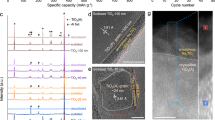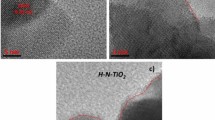Abstract
Titanium dioxide is considered to be promising anode for sodium-ion batteries due to stable structure during the charge/discharge process. However, its practical application is hindered by the slow electron/ion transport. Herein, phosphorus-doped anatase TiO2 nanoparticles with oxygen vacancies are successfully synthesized and utilized as high-performance sodium-storage materials. The dual strategy of phosphorus-doping and oxygen vacancies can concurrently boost electronic conductivity and adjust ion diffusion kinetics. They significantly contribute to the improved rate performance (167 mAh·g−1 at 20.0C) and stable cycling (95.9% after 2000 cycles at 20.0C). The proposed dual strategy can be potentially used to improve other oxide anodes for rechargeable batteries.
摘要
二氧化钛是一种非常有潜力的钠离子电池负极材料。然而, TiO2属于半导体材料, 离子扩散速率小和电子电导率低, 限制了其发展空间。本文成功合成了具有氧空位和磷掺杂的锐钛矿型TiO2纳米颗粒, 并将其用作钠离子电池负极材料。引入磷掺杂和氧空位的双重策略可以同时提高电子电导率和调节离子扩散动力学, 这对于提高高倍率性能 (在20.0 C下为容量为167 mAh·g-1) 和循环稳定性 (在20.0 C下循环2000次后容量保持率为95.9%) 起着重要作用。这项工作对改善二次电池氧化物负极材料的稳定性和储钠性能提供了可行的策略。






Similar content being viewed by others
Change history
08 January 2022
A Correction to this paper has been published: https://doi.org/10.1007/s12598-021-01915-w
References
Kong L, Tang C, Peng HJ, Huang JQ, Zhang Q. Advanced energy materials for flexible batteries in energy storage: a review. SmartMat. 2020;1(1):1007.
Wang LP, Yu L, Wang X, Srinivasan M, Xu ZJ. Recent developments in electrode materials for sodium-ion batteries. J Mater Chem A. 2015;3(18):9354.
Wang N, Chu C, Xu X, Du Y, Yang J, Bai Z, Dou S. Comprehensive new insights and perspectives into Ti-based anodes for next-generation alkaline metal (Na+, K+) ion batteries. Adv Energy Mater. 2018;8(27):1801888.
Zheng SM, Tian YR, Liu YX, Wang S, Hu CQ, Wang B, Wang KM. Alloy anodes for sodium-ion batteries. Rare Met. 2020;40(2):272.
Qi S, Wang H, He J, Liu J, Cui C, Wu M, Li F, Feng Y, Ma J. Electrolytes enriched by potassium perfluorinated sulfonates for lithium metal batteries. Sci Bull. 2021;66(7):685.
Li F, He J, Liu J, Wu M, Hou Y, Wang H, Qi S, Liu Q, Hu J, Ma J. Gradient solid electrolyte interphase and lithium-ion solvation regulated by bisfluoroacetamide for stable lithium metal batteries. Angew Chem Int Ed. 2021;60(12):6601.
Bommier C, Ji X. Electrolytes, SEI formation, and binders: a review of nonelectrode factors for sodium-ion battery anodes. Small. 2018;14(16):1703576.
Deng Z, Lin X, Huang Z, Meng J, Zhong Y, Ma G, Zhou Y, Shen Y, Ding H, Huang Y. Recent progress on advanced imaging techniques for lithium-ion batteries. Adv Energy Mater. 2018;8(4):1701428.
Liang K, He H, Ren Y, Wang H, Liao Y, Huang X. Porous lithium titanate nanosheets as an advanced anode material for sodium ion batteries. J Mater Sci. 2019;55(10):4373.
Liang K, Huang X, Hong X, Liao Y, Ren Y, Wang H. Sulfur and nitrogen-doped Li4Ti5O12/rGO as an anode material for advanced sodium-ion batteries. J Alloys Compd. 2021;857:158190.
Peng PP, Wu YR, Li XZ, Zhang JH, Li YW, Cui P, Yi TF. Toward superior lithium/sodium storage performance: design and construction of novel TiO2-based anode materials. Rare Met. 2021;40(11):3050.
Zhang ZJ, Zhao J, Qiao ZJ, Wang JM, Sun SH, Fu WX, Zhang XY, Yu ZY, Dou YH, Kang JL, Yuan D, Feng YZ, Ma JM. Nonsolvent-induced phase separation-derived TiO2 nanotube arrays/porous Ti electrode as high-energy-density anode for lithium-ion batteries. Rare Met. 2020;40(2):396.
Qi S, He J, Liu J, Wang H, Wu M, Li F, Wu D, Li X, Ma J. Phosphonium bromides regulating solid electrolyte interphase components and optimizing solvation sheath structure for suppressing lithium dendrite growth. Adv Funct Mater. 2020;31(11):2009013.
Lou S, Zhao Y, Wang J, Yin G, Du C, Sun X. Ti-based oxide anode materials for advanced electrochemical energy storage: lithium/sodium ion batteries and hybrid pseudocapacitors. Small. 2019;15(52):1904740.
Guo S, Yi J, Sun Y, Zhou H. Recent advances in titanium-based electrode materials for stationary sodium-ion batteries. Energy Environ Sci. 2016;9(10):2978.
Fan E, Li L, Wang Z, Lin J, Huang Y, Yao Y, Chen R, Wu F. Sustainable recycling technology for Li-ion batteries and beyond: challenges and future prospects. Chem Rev. 2020;120(14):7042.
Lewis C, Li YR, Wang L, Li J, Stach E, Takeuchi K, Marschilok A, Takeuchi E, Wong S. Correlating titania nanostructured morphologies with performance as anode materials for lithium-ion batteries. ACS Sustain Chem Eng. 2016;4(12):6302.
Lee G, Kang JK. Synthesis of nitrogen-doped mesoporous structures from metal-organic frameworks and their utilization enabling high performances in hybrid sodium-ion energy storages. Adv Sci. 2020;7(6):1902986.
Gan Q, He H, Zhu Y, Wang Z, Qin N, Gu S, Li Z, Luo W, Lu Z. Defect-assisted selective surface phosphorus doping to enhance rate capability of titanium dioxide for sodium ion batteries. ACS Nano. 2019;13(8):9253.
Zhang W, Luo N, Huang S, Wu NL, Wei M. Sulfur-doped anatase TiO2 as an anode for high-performance sodium-ion batteries. ACS Appl Energy Mater. 2019;2(5):3792.
Hwang J, Myung S, Lee J, Abouimrane A, Belharouak I, Sun Y. Ultrafast sodium storage in anatase TiO2 nanoparticles embedded on carbon nanotubes. Nano Energy. 2015;16:218. https://doi.org/10.1016/j.nanoen.2015.06.017.
Cao M, Tao L, Lv X, Bu Y, Li M, Yin H, Zhu M, Zhong Z, Shen Y, Wang M. Phosphorus-doped TiO2-B nanowire arrays boosting robust pseudocapacitive properties for lithium storage. J Power Sources. 2018;396:329.
Wang Q, He H, Luan J, Tang Y, Huang D, Peng Z, Wang H. Synergistic effect of N-doping and rich oxygen vacancies induced by nitrogen plasma endows TiO2 superior sodium storage performance. Electrochim Acta. 2019;309:248.
Ni Q, Dong R, Bai Y, Wang Z, Ren H, Sean S, Wu F, Xu H, Wu C. Superior sodium-storage behavior of flexible anatase TiO2 promoted by oxygen vacancies. Energy Storage Mater. 2020;25:905.
Bai YL, Wu XY, Liu YS, Ma C, Wei X, Wang KX, Chen JS. Dandelion-clock-inspired preparation of core-shell TiO2@MoS2 composites for high performance sodium ion storage. J Alloys Compd. 2020;815:152386.
Chen J, Luo B, Chen Q, Li F, Guo Y, Wu T, Peng P, Qin X, Wu G, Cui M, Liu L, Chu L, Jiang B, Li Y, Gong X, Chai Y, Yang Y, Chen Y, Huang W, Liu X, Li M. Localized electrons enhanced ion transport for ultrafast electrochemical energy storage. Adv Mater. 2020;32(14):1905578.
Wang Y, Zhu W, Guerfi A, Kim C, Zaghib K. Roles of Ti in electrode materials for sodium-ion batteries. Front Energy. 2019. https://doi.org/10.3389/fenrg.2019.00028.
Bai YL, Xarapatgvl R, Wu XY, Liu X, Liu YS, Wang KX, Chen JS. Core-shell anatase anode materials for sodium-ion batteries: the impact of oxygen vacancies and nitrogen-doped carbon coating. Nanoscale. 2019;11(38):17872.
He H, Huang D, Pang W, Sun D, Wang Q, Tang Y, Ji X, Guo Z, Wang H. Plasma-induced amorphous shell and deep cation-site s doping endow tio2 with extraordinary sodium storage performance. Adv Mater. 2018;30(26):1801013.
He H, Zhang Q, Wang H, Zhang H, Li J, Peng Z, Tang Y, Shao M. Defect-rich TiO2-δ nanocrystals confined in a mooncake-shaped porous carbon matrix as an advanced Na ion battery anode. J Power Sources. 2017;354:185.
Ni J, Fu S, Yuan Y, Ma L, Jiang Y, Li L, Lu J. Boosting sodium storage in TiO2 nanotube arrays through surface phosphorylation. Adv Mater. 2018;30(6):1704337.
Chen J, Ding Z, Wang C, Hou H, Zhang Y, Wang C, Zou G, Ji X. Black anatase titania with ultrafast sodium-storage performances stimulated by oxygen vacancies. ACS Appl Mater Interfaces. 2016;8(14):9148.
Zhai T, Wan L, Sun S, Chen Q, Sun J, Xia Q, Xia H. Phosphate ion functionalized Co3O4 ultrathin nanosheets with greatly improved surface reactivity for high performance pseudocapacitors. Adv Mater. 2017;29(7):1604167.
Xia Q, Huang Y, Xiao J, Wang L, Lin Z, Li W, Liu H, Gu Q, Liu HK, Chou SL. Phosphorus-modulation-triggered surface disorder in titanium dioxide nanocrystals enables exceptional sodium-storage performance. Angew Chem Int Ed Engl. 2019;58(12):4022.
Yan D, Yu C, Zhang X, Li J, Li J, Lu T, Pan L. Enhanced electrochemical performances of anatase TiO2 nanotubes by synergetic doping of Ni and N for sodium-ion batteries. Electrochim Acta. 2017;254:134.
Tian J, Li J, Zhang Y, Yu XY, Hong Z. Carbon-coated CoSe2 nanoparticles confined in N-doped carbon microboxes with enhanced sodium storage properties. J Mater Chem A. 2019;7(37):21404.
Song T, Chen H, Li Z, Xu Q, Liu H, Wang Y, Xia Y. Creating an air-stable sulfur-doped black phosphorus-TiO2 composite as high-performance anode material for sodium-ion storage. Adv Funct Mater. 2019;29(22):1900535.
Zhang Y, Wang C, Hou H, Zou G, Ji X. Nitrogen doped/carbon tuning yolk-like TiO2 and its remarkable impact on sodium storage performances. Adv Energy Mater. 2017;7(4):1600173.
Li B, Anwer S, Huang X, Luo S, Fu J, Liao K. Nitrogen-doped carbon encapsulated in mesoporous TiO2 nanotubes for fast capacitive sodium storage. J Energy Chem. 2021;55:205.
Ma L, Gao X, Zhang W, Yuan H, Hu Y, Zhu G, Chen R, Chen T, Tie Z, Liu J, Wu T, Jin Z. Ultrahigh rate capability and ultralong cycling stability of sodium-ion batteries enabled by wrinkled black titania nanosheets with abundant oxygen vacancies. Nano Energy. 2018;53:94.
Wu N, Qiao X, Shen J, Liu G, Sun T, Wu H, Hou H, Liu X, Zhang Y, Ji X. Anatase inverse opal TiO2-x@N-doped C induced the dominant pseudocapacitive effect for durable and fast lithium/sodium storage. Electrochim Acta. 2019;299:544.
Le Z, Liu F, Nie P, Li X, Liu X, Bian Z, Chen G, Wu HB, Lu Y. Pseudocapacitive sodium storage in mesoporous single-crystal-like TiO2-graphene nanocomposite enables high-performance sodium-ion capacitors. ACS Nano. 2017;11(3):2952.
Liu DS, Liu DH, Hou BH, Wang YY, Guo JZ, Ning QL, Wu XL. 1D porous MnO@N-doped carbon nanotubes with improved Li-storage properties as advanced anode material for lithium-ion batteries. Electrochim Acta. 2018;264:295.
Li L, Zhang N, Su Y, Zhao J, Song Z, Qian D, Wu H, Tahir M, Saeed A, Ding S. Fluorine dissolution-induced capacity degradation for fluorophosphate-based cathode materials. ACS Appl Mater Interfaces. 2021;13(20):23789.
Zhao B, Liu Q, Chen Y, Liu Q, Yu Q, Wu HB. Interface-induced pseudocapacitance in nonporous heterogeneous particles for high volumetric sodium storage. Adv Funct Mater. 2020;30(42):2002019.
Wu L, Bresser D, Buchholz D, Giffin G, Castro C, Ochel A, Passerini S. Unfolding the mechanism of sodium insertion in anatase TiO2 nanoparticles. Adv Energy Mater. 2015;5(2):1401142.
Lin D, Li K, Wang Q, Lyu L, Li B, Zhou L. Rate-independent and ultra-stable low-temperature sodium storage in pseudocapacitive TiO2 nanowires. J Mater Chem A. 2019;7(33):19299.
Wu CP, Xie KX, He JP, Wang QP, Ma JM, Yang S, Wang QH. SnO2 quantum dots modified N-doped carbon as high-performance anode for lithium ion batteries by enhanced pseudocapacitance. Rare Met. 2020;40(1):52.
Acknowledgements
This study was financially supported by the National Natural Science Foundation of China (Nos. 91961126 and 22078029), Zhejiang Provincial Natural Science Foundation (No. LR21E020003) and Postgraduate Research & Practice Innovation Program of Jiangsu Province (No. SJCX21_1180). The authors also thank Jiangsu Development & Reform Commission and Changzhou Development & Reform Commission for their support.
Author information
Authors and Affiliations
Corresponding authors
Ethics declarations
Conflicts of interests
The authors declare that they have no conflict of interests.
Additional information
The original online version of this article was revised due to the update in the affiliation of the 5th author (Corresponding author).
Supplementary Information
Below is the link to the electronic supplementary material.
Rights and permissions
About this article
Cite this article
Zhao, HS., Qi, YL., Liang, K. et al. Phosphorus-doping and oxygen vacancy endowing anatase TiO2 with excellent sodium storage performance. Rare Met. 41, 1284–1293 (2022). https://doi.org/10.1007/s12598-021-01864-4
Received:
Revised:
Accepted:
Published:
Issue Date:
DOI: https://doi.org/10.1007/s12598-021-01864-4




